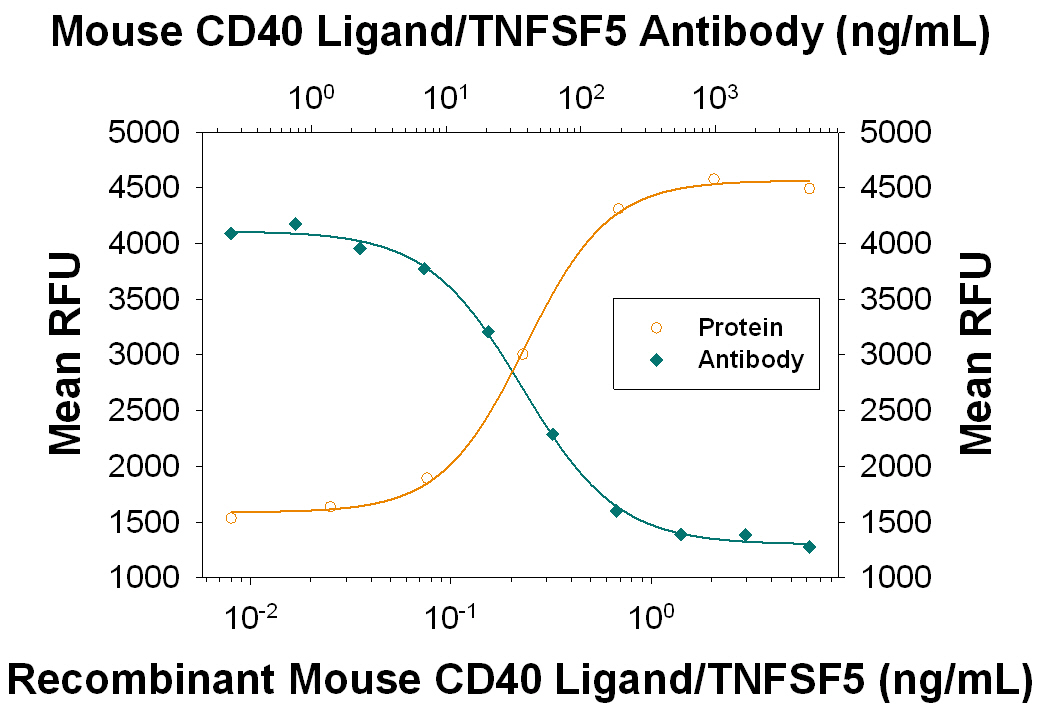Mouse CD40 Ligand/TNFSF5 Antibody Summary
Glu61-Leu260
Accession # P27548
Applications
Please Note: Optimal dilutions should be determined by each laboratory for each application. General Protocols are available in the Technical Information section on our website.
Scientific Data
 View Larger
View Larger
Detection of CD40 Ligand/TNFSF5 in Mouse Splenocytes by Flow Cytometry. Mouse splenocytes either (A) stimulated to induce Th1 cells or (B) unstimulated were stained with Rat Anti-Mouse CD40 Ligand/TNFSF5 Monoclonal Antibody (Catalog # MAB1163) followed by Allophycocyanin-conjugated Anti-Rat IgG Secondary Antibody (Catalog # F0113) and Rat Anti-Mouse CD4 PE-conjugated Monoclonal Antibody (Catalog # FAB554P). Quadrant markers were set based on control antibody staining (Catalog # MAB006). View our protocol for Staining Membrane-associated Proteins.
 View Larger
View Larger
Proliferation Induced by CD40 Ligand/TNFSF5 and Neutralization by Mouse CD40 Ligand/TNFSF5 Antibody. Recombinant Mouse CD40 Ligand/TNFSF5 (Catalog # 8230-CL) induces proliferation in mouse splenic B cells in a dose-dependent manner (orange line), as measured by Resazurin (Catalog # AR002). Proliferation elicited by Recombinant Mouse CD40 Ligand/TNFSF5 (0.5 ng/mL) is neutralized (green line) by increasing concentrations of Rat Anti-Mouse CD40 Ligand/TNFSF5 Monoclonal Antibody (Catalog # MAB1163). The ND50 is typically 0.0075-0.045 µg/mL.
Reconstitution Calculator
Preparation and Storage
- 12 months from date of receipt, -20 to -70 °C as supplied.
- 1 month, 2 to 8 °C under sterile conditions after reconstitution.
- 6 months, -20 to -70 °C under sterile conditions after reconstitution.
Background: CD40 Ligand/TNFSF5
CD40 ligand (CD40L; also known as CD154, TNFSF5, TRAP, or gp39) is a 260 amino acid (aa) type II transmembrane glycoprotein belonging to the TNF family. Mouse CD40L consists of a 22 aa cytoplasmic domain, a 24 aa transmembrane domain, and 214 aa extracellular domain bearing a single glycosylation site (1, 2). CD40L is expressed predominantly on activated CD4+ T lymphocytes and also found in other types of cells, including NK cells, mast cells, basophils, and eosinophils. Murine CD40L shares 78% amino acid sequence identity with human CD40L. Native bioactive soluble CD40L exists. Soluble human trimeric CD40L secreted by stimulated T cells has been shown to be generated by proteolysis in the microsomes (3). Both membrane bound and soluble CD40L induce similar effects on B cells (3, 4). The receptor of CD40L is CD40, a type I transmembrane glycoprotein belonging to the TNF receptor family. CD40 is expressed on B lymphocytes, monocytes, dendritic cells, and thymic epithelium. Although all monomeric, dimeric, and trimeric forms of soluble CD40L can bind to CD40, the soluble trimeric form of CD40L has the most potent biological activity through oligomerization of cell surface CD40, a common feature of TNF receptor family members (2). The genetic defect in the hyper-IgM syndrome is due to point mutations or deletions of the gene encoding the CD40L, which prevent CD40L from interacting with CD40 (5‑7). CD40L mediates a range of activities on B cells including induction of activation-associated surface antigen, entry into the cell cycle, isotype switching, Ig secretion, and memory generation (8, 9). CD40-CD40L interaction also plays important roles in monocyte activation and dendritic cell maturation (10).
- Armitage, R.J. et al. (1992) Nature 357:80.
- Hollenbaugh, D. et al. (1992) EMBO J. 11:4313.
- Fabienne, P. et al. (1996) J. Biol. Chem. 271:5965.
- Fabienne, P. et al. (1996) Eur. J. Immunol 26:725.
- Arrufo, A. et al. (1993) Cell 72:291.
- Hill, A. and N. Chapel et al. (1993) Nature 361:494.
- Korthauer, U. et al. (1993) Nature 361:539.
- Spriggs, M.K. et al. (1992) J. Exp. Med. 176:1543.
- Fanslow, W.C. et al. (1994) Seminars in Immunology 6:267.
- Kooten, C.V. and J. Banchereau (2000) J. Leukoc. Biol. 67:2.
Product Datasheets
Citation for Mouse CD40 Ligand/TNFSF5 Antibody
R&D Systems personnel manually curate a database that contains references using R&D Systems products. The data collected includes not only links to publications in PubMed, but also provides information about sample types, species, and experimental conditions.
1 Citation: Showing 1 - 1
-
Role of Valpha14+ NKT cells in the development of Hepatitis B virus-specific CTL: activation of Valpha14+ NKT cells promotes the breakage of CTL tolerance.
Authors: Ito H, Ando K, Ishikawa T
Int. Immunol., 2008-05-16;20(7):869-79.
Species: Mouse
Sample Types: In Vivo
Applications: Neutralization
FAQs
No product specific FAQs exist for this product, however you may
View all Antibody FAQsReviews for Mouse CD40 Ligand/TNFSF5 Antibody
There are currently no reviews for this product. Be the first to review Mouse CD40 Ligand/TNFSF5 Antibody and earn rewards!
Have you used Mouse CD40 Ligand/TNFSF5 Antibody?
Submit a review and receive an Amazon gift card.
$25/€18/£15/$25CAN/¥75 Yuan/¥2500 Yen for a review with an image
$10/€7/£6/$10 CAD/¥70 Yuan/¥1110 Yen for a review without an image



